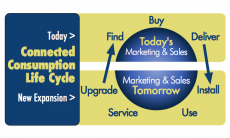In 1909, Henry Ford said that the buyers could have their car painted in any color they wanted, as long as it was black.
This statement has been reinterpreted for decades now, but do you know the idea behind it?
When developing the famous Model T, Ford wanted it to be made out of the highest-quality materials and to be designed by the best people in the industry. At the same time, he wanted it to be affordable to anyone. His idea was to reduce the price of the car by creating a single car model that would fit any customer’s needs. “There is a tendency to keep monkeying with styles and to spoil a good thing by changing it,” Ford explained in My Life and Work.
Ford believed that the manufacturers should focus on the 95% of the customers that purchased without making any complaints or suggestions, and not 5% of special customers that expected personalized products.
This approach to manufacturing and sales worked back then. Today? Not so much.
In today’s era of personalization, one-size-fits-all products don’t work. A modern customer is demanding: they are aware of the multitude of similar brands and products on the market and they’ll compare them until they find the one that meets their needs best. Most importantly, they want brands to appreciate and address their individual needs and preferences.
This makes small businesses ask themselves whether it is possible to personalize their mass production processes and, at the same time, increase their revenue.
This is where mass customization can help.
What Is Mass Customization?
Mass customization helps you get the best of both mass production and product personalization. In other words, you’re targeting different customer groups, researching their needs, and adapting your wide-market products to them.
Mass customization can be used in virtually any industry. The changes you make to a product could be as small as using different colors or as complex as adding new features. For example, the same laptop model is available at different hard disk capacities, RAM sizes, and colors. The same goes for buying a piece of software. Apart from some basic features, many software creators let customer add or change the features and functionalities of the product.
As a result, they deliver personalized user experiences to wider groups at the lower cost.
The Four Approaches to Mass Customization
There are different approaches to mass customization and the most common ones were defined by B. Joseph Pine II:
- Collaborative customization: Your small business relies on customer feedback. You communicate with your customers regularly, ask them for opinions, and help them understand their needs and goals. Based on that, you create highly personalized products. This is particularly helpful if your audiences are still struggling to understand what they expect of you.
- Adaptive customization: This is exactly what I explained in the abovementioned example of developing a piece of software. Namely, you create a standardized product, but allow customers to change it later.
- Cosmetic customization: Your small business should adopt it if your product already meets the needs of almost any customer group. In this case, you’re changing the way you market your product. Your goal is to understand how a user wants your product to be presented and, based on that, you create multiple promotion and advertising programs when marketing to different audience segments.
- Transparent customization: Your business provides highly personalized products for different customer groups without telling them that. This is especially effective when the customers’ needs are predictable or when customers do not want to provide feedback continually.
The Benefits of Mass Customization and How to Implement It
Now that you understand the fundamental approaches to mass customization, it’s time to learn more about its implementation. Here are a few simple rules that may serve as a nice starting point for you.
Update your Buyer Personas.
A buyer persona is the backbone of your small business. It lets you understand your target customer and adapt your products and marketing to their needs. B
Collect Customer Feedback Regularly.
No matter if you’re a software developer or a sports apparel designer, collecting customer feedback is critical for your success. Only by understanding what your customers are thinking of you will you be able to adapt your offers to their needs.
Now, there are numerous ways to collect customer feedback. For example, you could encourage online reviews, have your customer support reps collect customer feedback via phone, create email or SMS surveys, ask for post-purchase customer feedback, etc.
You could even reward them for participation through giving away branded promotional products that are relevant for your customers. For example, if you’re rewarding corporate clients, then giving away personalised pens or notebooks with your logo may be a good choice. If you’re incentivizing tech-savvy Millennials, choose items like on-the-go phone chargers, Bluetooth speakers, or wireless earbuds
Customization doesn’t Need to Be Complicated.
When it comes to implementing mass customization, there is a world of possibilities waiting for you. For example, you could:
- Localize your offers tactics to adapt to the distinctive needs of different global markets. The idea is to sell the products that make sense for your customers. Most importantly, you should make your products available to relevant local audiences by localizing your marketing campaigns.
- Tailor your catalog products to your major customer groups.
- Invest in multi-channel customer support. Today’s customers expect you to be available to them 24/7, across multiple communication channels. Therefore, apart from some basic methods of communication such as email or phone conversations, you should also use social networks, live chat, and chatbots, automated email tools, to provide real-time customer feedback.
Understand the major customization barriers and fight them.
There are numerous problems your small business may face during the mass customization problems.
For starters, this strategy doesn’t work the same for all businesses. Luxury brands may generate a far greater ROI from mass customization than businesses creating basic products.
Second, customized products are more expensive and take more time to be developed and delivered to a customer.
Finally, there is also the problem of supply chains. The systems of suppliers are usually based on pre-arranged amounts of products and they don’t support unforeseen shifts it the product demand.
These issues are common, but they shouldn’t scare you off. Instead, do your research to identify the major problems you may be facing when using mass customization, from prototyping to marketing, and prepare for them on time.
Over to You
Even though these are still the beginnings of mass customization, it is obvious that it will soon replace mass production. It benefits both small businesses and their customers. For businesses, it means increasing sales through personalization, while consumers will receive better, more relevant user experiences with every purchase.









